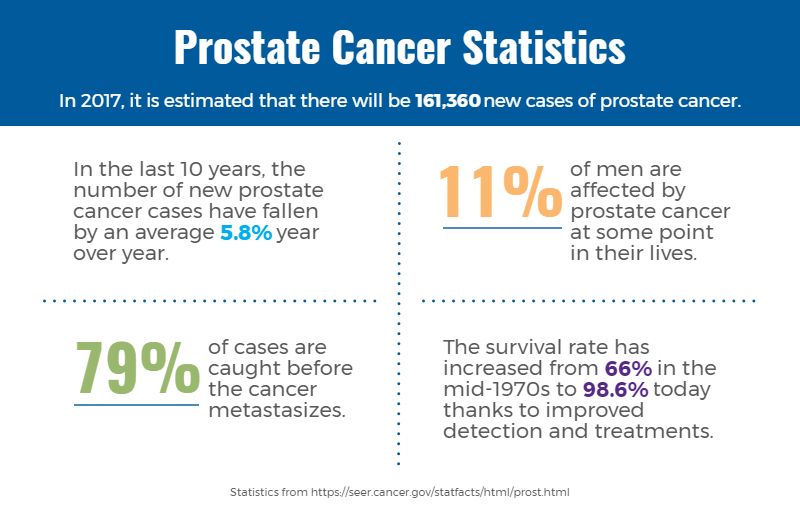As Men’s Health Month wraps up, here are three important takeaways about prostate cancer, which affects 11 percent of men at some point in their lives.
Prostate cancer is one of the most common cancers in men, but incidence is dropping and survival
is rising.
This year, an estimated 161,360 men will be diagnosed with prostate cancer, according to the National Cancer Institute. In the last 10 years, the number of new prostate cancer cases have fallen by an average 5.8 percent year over year. At the same time, survival is increasing—from 66 percent in the mid-1970s to 98.6 percent today thanks to improved detection and treatments.
Prostate cancer can take a long time to develop.
Most prostate cancers are slow growing, so much so that they are usually not diagnosed until later in life and may not ever cause life-threatening symptoms (in fact, it sometimes can take 10 to 30 years for a tumor to get big enough to be problematic, according to NCI). Others, however, can progress more quickly, necessitating intensive treatment such as surgical removal of the prostate. Accurately predicting the course of a person’s cancer can be challenging and is the focus of intense research aimed at preventing over-diagnosis and unnecessary treatment. You can find more information about prostate cancer screening here.
Thankfully, the majority of cases—79 percent—are caught before the cancer metastasizes, or spreads beyond the prostate. Another 12 percent are detected after regional spread to the lymph nodes. In both cases, the disease is typically very treatable. You can find more statistics here.
When it does spread, prostate cancer has an affinity for metastasizing to the bones.
But why? What makes the bones such an attractive site for prostate cancer cells?
Scientists, such as VARI’s Dr. Xiaohong Li, are working hard to answer this question.
“Bone and its surrounding environment are incredibly rich environments, full of growth factors that stimulate cellular growth and aid in cellular communication,” Li said. “Cancer cells by their very nature are marked by uncontrolled growth and invasive spread. They can be likened to seeds finding fertile soil, in this case in the bone.”
Li and her team study the factors that make bone a hospitable site for prostate cancer cells, particularly a molecule called transforming growth factor, or TGF-b. In healthy bone, TGF-b acts as a maintenance worker of sorts, keeping up the balance between bone resorption and formation. In prostate cancer, TGF-b stimulates the growth of malignant cells, which subsequently hijack the normal maintenance cycle of bones and cause damage. The role of TGF-b in both normal bone and in cancer makes it a promising target for identifying new treatments.
“Since 2010, the FDA has approved six different treatments that demonstrated improved survival for prostate cancer patients with bone metastasis in clinical trials. This is great and very exciting for patients, their families and us, as medical researchers in the field,” Li said. “However, later studies showed that the cancer became resistant to some of these therapies, causing them to eventually stop working in almost all patients. Thus, there is still an urgent need to identify new targets and develop novel approaches to treating prostate cancer bone metastases. TGF-b and similar molecules offer an exciting avenue that I hope will lead to new preventative strategies and treatments.”
Read more about Dr. Li’s work here. For more information on prostate cancer from the National Cancer Institute, click here. Van Andel Research Institute does not treat patients and cannot provide medical advice. Screening and treatment decisions should be made in close consultation with your physician.
